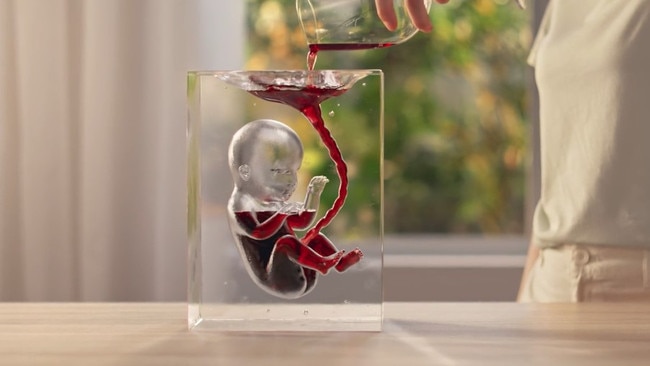How glass baby campaign hit home for mums-to-be
New research from the Australian and New Zealand Journal of Public Health reveals how an advertising campaign has helped support alcohol-free pregnancies.

A study published in the Australian and New Zealand Journal of Public Health has revealed new data on the efficacy of an advertising campaign designed to support alcohol-free pregnancies.
The “One Drink” campaign aired in Western Australia between January 2021 and May 2022 and was developed by the WA Mental Health Commission in collaboration with Cancer Council WA. Advertising agency 303 Mullenlowe in Perth was engaged to develop the campaign, which appeared on a range of media channels including TV, outdoors, health care centres, radio, digital and social media.
In what is becoming a textbook case study of advertising for behaviour change and public health impact, the campaign has already been recognised for its effectiveness in the advertising industry – it collected two Bronze Effies at the prestigious Australian Effie Awards in 2022.
One Drink was first funded by the then McGowan state government in 2020 as part of a $2.7m Foetal Alcohol Spectrum Disorder (FASD) Prevention Package. Initially funded for two years, the program aimed to raise awareness among pregnant women, those planning a pregnancy and the broader community of the risks associated with FASD.
The campaign features a disconcerting visual of a baby-shaped glass being filled with red wine – a design choice that illustrates how a pregnant mother’s consumption of alcohol affects her baby. It conveys: what a mother drinks, the baby she carries also drinks.
The new study found the campaign was highly effective in terms of reach and intended impact to dissuade pregnant women from drinking alcohol, with 76 per cent of survey respondents saying they recalled seeing the campaign.
After the campaign aired, 95 per cent of women reported intending to abstain from drinking when pregnant. Both males and females were also more likely to agree that pregnant women should not drink any alcohol, according to the research.
The results of the campaign outlined in the study also pointed to a broader issue among audiences who have been exposed to a range of different messages and advice about drinking alcohol during pregnancy over the years.
Messages about the issue had been “muddied”, Cancer Council Western Australia alcohol program manager Julia Stafford said.
Some advertising campaigns might have also contributed to confusion among audiences, Ms Stafford explained.
A 2018 DrinkWise campaign, for example, was forced to recall its collateral from doctors clinics and hospitals after its wording included misleading information in its fine print about drinking during pregnancy.
The alcohol industry body subsequently released a second iteration of the campaign with clearer messaging, warning women to abstain from drinking alcohol while pregnant, planning a pregnancy or breastfeeding.
“Advertising is the wallpaper to our lives,” Ms Stafford said.
“We have access to alcohol almost everywhere we go in our social life, in our shopping and online. It’s so normalised that by the time we might be thinking about having a baby (or) might be pregnant, the fact that alcohol is such a huge part of our lives muddies the message that alcohol is harmful, particularly for the developing baby.”
Lead author of the report, Professor Simone Pettigrew from The George Institute for Global Health, said the organisation had previously found one in two people who viewed the campaign agreed it contained new health information, highlighting the misinformation problem that the project aims to tackle.
Independent research from the Mental Health Commission found that mixed advice is coming from a range of sources including “Dr Google”, conflicting advice from medical experts, the media and even well-intentioned friends and relatives. It was based upon these research insights that the creative solution was built, 303 Mullenlowe Perth’s managing director Rene Migliore said.
“The fact that this campaign strategy was fully informed by research was critical,” he said.
“We invested time to understand the thoughts, feelings and beliefs of the target audience through rigorous research that enabled us to uncover insights that ultimately led to meaningful attitudinal and behavioural shifts in the community.
“With the very simple key message of ‘Any amount a mother drinks, the baby drinks’, we were able to really focus the visual representation of that message with a striking visual demonstration – a glass baby.” He said it resonated because it used familiar visual cues, such as a wine bottle, a wine class and a visual of a baby in utero.
“In bringing those very familiar visual cues together that would normally not coexist; it jolts our expectations,” Mr Migliore said.
“We brought together the very familiar with the very unexpected, a classic rug-pull.”
The visuals in the campaign are simple but powerful and make for uncomfortable viewing. But a bold creative approach is often necessary to make an impact, Professor Pettigrew said.
“They don’t have to be really hard-hitting to have any effect," she said. “But they often need to be hard hitting to have the best effect. And that’s partly for cut-through reasons. There’s just so much in people’s environments – they’ve been hit with advertising stimuli all the time.”
As a national campaign on the issue is also now in-market, following suit on WA’s campaign, Public Health Association of Australia chief executive and Adjunct Professor Terry Slevin said for true, lasting efficacy, a sustained approach was needed.
As parent cohorts changed, there was a need for consistent communication to those groups over long periods, he said.
“The challenge is to ensure these messages aren’t just delivered in a narrowcast period of time, but they’re available and promoted consistently in an ongoing way,” he said. “The new parents in 2023 will be different to the new parents in 2025, and 2026 and 2027. These campaigns are also important to send the signal to the community broadly that alcohol, and controls with regard to alcohol, are important issues for public health.
“That’s relevant to all voters – the community, individuals, people considering how they vote next time around, (and) also policymakers,” Mr Slevin added.
“The alcohol industry promotes its products 24/7, 365. And there’s a responsibility of the health sector and government particularly to support (in) some kind of capacity to counterbalance that extraordinary investment the alcohol industry makes in promoting its product.”







